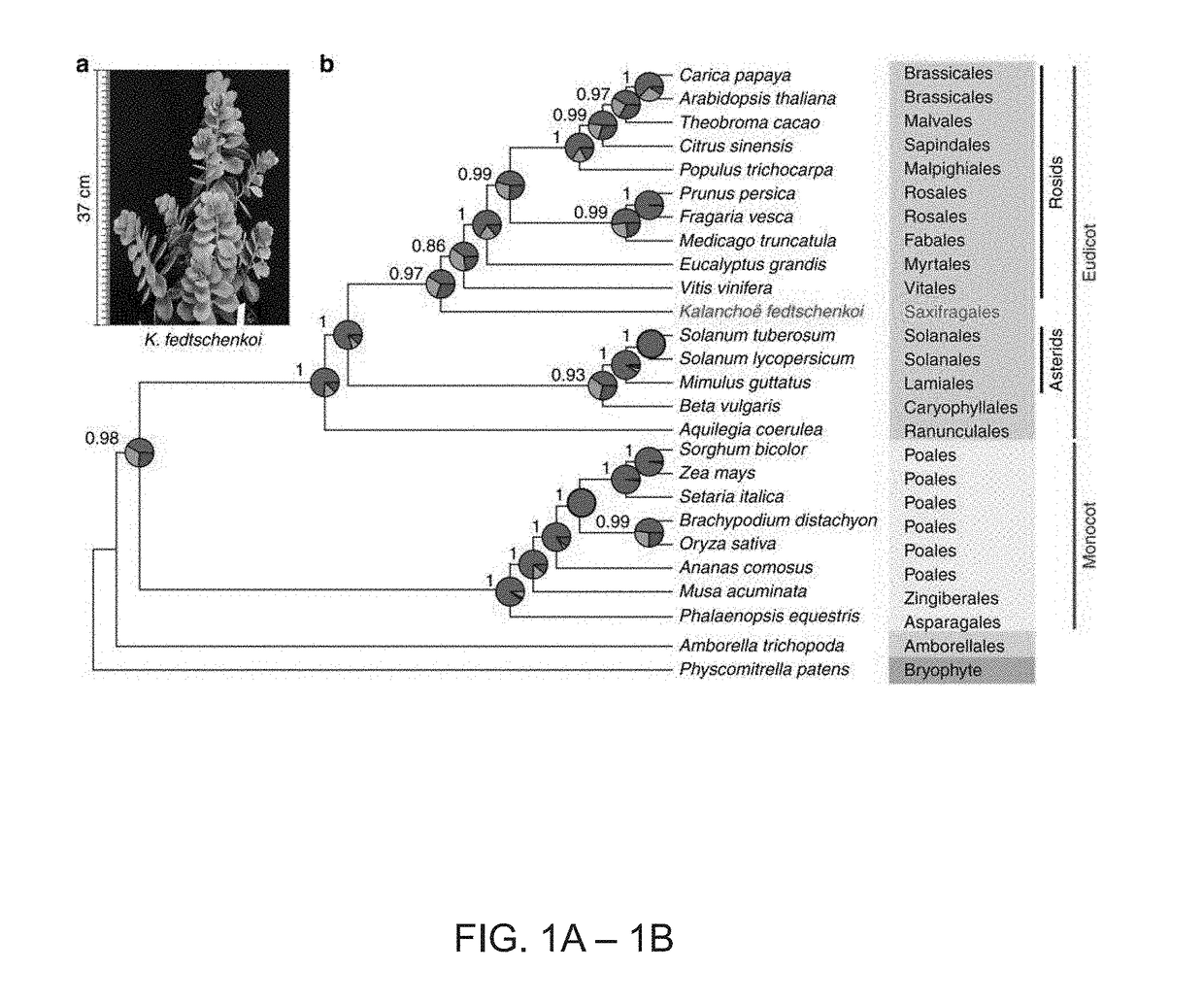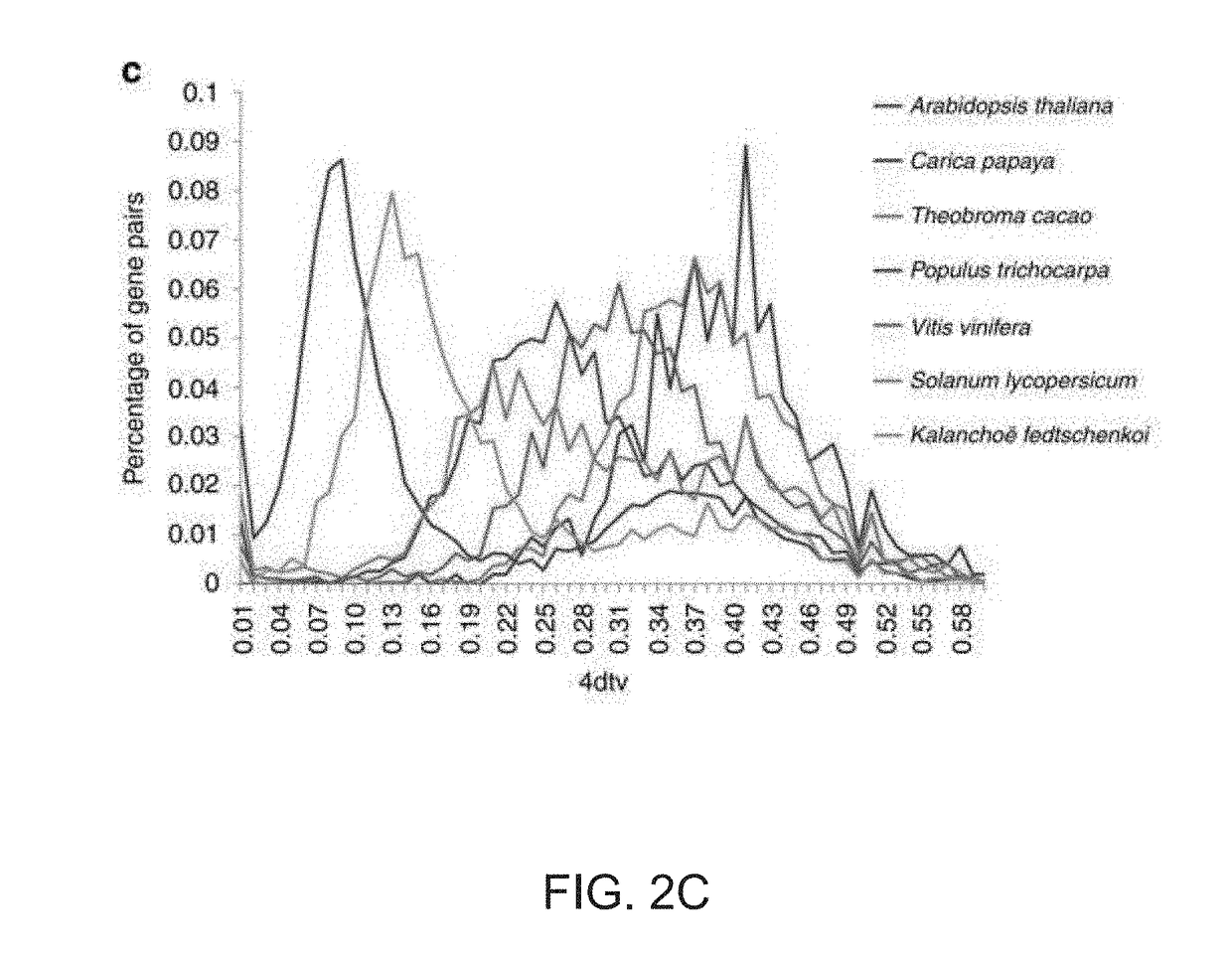Genes for enhancing drought and heat tolerance in plants and methods of use
- Summary
- Abstract
- Description
- Claims
- Application Information
AI Technical Summary
Benefits of technology
Problems solved by technology
Method used
Image
Examples
example 1
Kalanchoë Genome Assembly and Annotation
[0108]The diploid K. fedtschenkoi (2n=2x=34 chromosomes) genome size was estimated to be ˜260 Mb. The K. fedtschenkoi genome was assembled from ˜70× paired-end reads and ˜37× mate-pair reads generated using an Illumina MiSeq platform. The genome assembly consisted of 1,324 scaffolds with a total length of 256 Mb and scaffold N50 of 2.45 Mb, in which the inventors predicted and annotated 30,964 protein-coding genes.
example 2
The Phylogenetic Placement of Kalanchoë
[0109]Kalanchoë is the first eudicot CAM lineage with a genome sequence to date and serves as an important reference for understanding the evolution of CAM. In addition, K. fedtschenkoi is the first sequenced species in the distinct eudicot lineage, Saxifragales. Although the monophyly of this morphologically diverse order is well supported by molecular data, its phylogenetic placement has been less clear (Soltis et al., 2013, American Journal of Botany, 100: 916-929). The recent consensus view, based mainly on analyses of plastid DNA sequences, has placed the Saxifragales as a sister group to the rosids, and together they comprise the large Glade of superrosids (The Angiosperm Phylogeny Group, 2016, Botanical Journal of the Linnean Society, 181: 1-20; Zeng et al., 2017, New Phytologist, 214: 1338-1354). However, there have been indications of conflict between trees based on plastid genomes and nuclear genomes for this Glade (Cal et al., 2015, ...
example 3
Kalanchoë Genome Duplication
[0111]The grape genome has no additional genome duplication after the ancestral gamma hexaploidization (Jaillon et al., 2007, Nature, 449: 463-467; Murat et al., 2015, Genome Biology and Evolution, 7: 735-749) and is the best available reference for studying ancestral eudicot genome duplication events. Syntenic depth analyses (Paterson et al., 2012, Nature, 492: 423-427; Amborella Genome Project, 2013, Science, 342: 1241089) showed that there are multiple K. fedtschenkoi blocks covering each grape gene (FIG. 2A). Specifically, 65% of the grape genome had from one to four syntenic blocks in K. fedtschenkoi. In contrast, a sudden drop in syntenic depth occurred after a depth of 4× (FIG. 2A), indicating that each grape genome region has up to four K. fedtschenkoi blocks and thus providing strong evidence for two distinct whole-genome duplications (WGDs) events in K. fedtschenkoi. The microsynteny patterns further support two WGDs on the lineages leading to K...
PUM
| Property | Measurement | Unit |
|---|---|---|
| Electrical conductance | aaaaa | aaaaa |
| Volume | aaaaa | aaaaa |
| Fraction | aaaaa | aaaaa |
Abstract
Description
Claims
Application Information
 Login to View More
Login to View More - R&D
- Intellectual Property
- Life Sciences
- Materials
- Tech Scout
- Unparalleled Data Quality
- Higher Quality Content
- 60% Fewer Hallucinations
Browse by: Latest US Patents, China's latest patents, Technical Efficacy Thesaurus, Application Domain, Technology Topic, Popular Technical Reports.
© 2025 PatSnap. All rights reserved.Legal|Privacy policy|Modern Slavery Act Transparency Statement|Sitemap|About US| Contact US: help@patsnap.com



